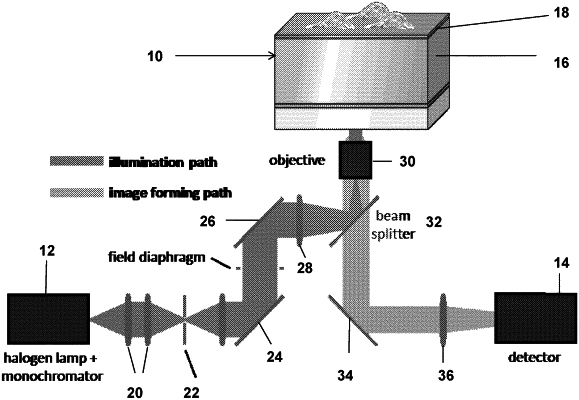| CPC G01N 33/4833 (2013.01) [G01L 1/24 (2013.01); G01L 5/0052 (2013.01); G01N 13/00 (2013.01); G01N 33/483 (2013.01); G01N 2203/0089 (2013.01)] | 19 Claims |

|
1. A system for measuring cellular forces exerted on a surface comprising:
a variable wavelength light source that emits light having variable wavelengths and that performs a wavelength scan comprising emitting light over a wavelength scan range; and
a sensor comprising:
a first layer, wherein the first layer at least partially reflects the light emitted from the variable wavelength light source and wherein the first layer comprises a resiliently deformable surface adapted to deform on application of a cellular force;
a further layer that reflects and transmit the light emitted from the variable wavelength light source; and
an elastomer layer provided between the first layer and the further layer;
wherein the first layer and the further layer define an optical cavity such that the elastomer layer is included in the optical cavity, wherein, in use, light provided to the optical cavity is at least partially reflected by the first layer and at least partially reflected by the further layer, to form an interference pattern in the optical cavity,
wherein the optical cavity comprises an undeformed thickness, wherein the application of the cellular force to the resiliently deformable surface of the first layer causes a change in thickness of the optical cavity, and wherein the interference pattern formed between the first layer and the further layer is dependent on the thickness of the optical cavity and a respective wavelength of the light emitted from the variable wavelength light source such that reflectivity of light is reduced at a resonant wavelength, and
wherein the variable wavelength light source is positioned relative to the sensor such that, in use, light emitted from the variable wavelength light source is first transmitted by the further layer and then reflected by the first layer;
wherein the system further comprises:
an optical detector that optically detects light emitted from the optical cavity as a function of the wavelengths of the light to detect a thickness change of the optical cavity, wherein the thickness change is dependent on the cellular force applied to the resiliently deformable surface, and wherein the optical detector identifies at least one resonant wavelength in the wavelength scan range using the detected light and determines the thickness change based on the identified at least one resonant wavelength.
|